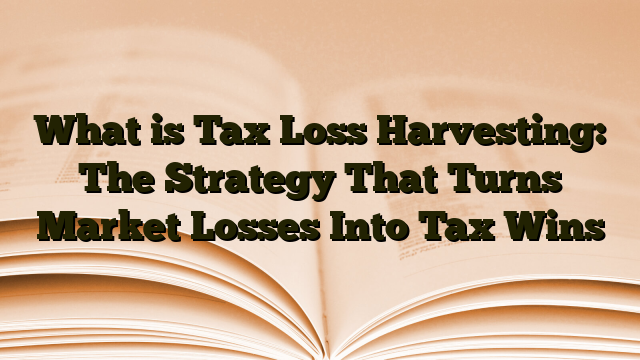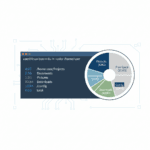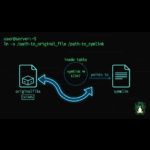I used to think market losses were just… losses. Pure pain. Something to avoid at all costs. Then I learned about tax loss harvesting, and suddenly those red numbers in my brokerage account became useful. Not pleasant, mind you, but useful.
Tax loss harvesting is when you sell investments that are down to lock in a loss, then use that loss to reduce your taxes. You’re not giving up on the market—you reinvest the money immediately into something similar. It’s a legal way to make lemonade from financial lemons, and once you understand how it works, you’ll wonder why everyone with a taxable brokerage account isn’t doing this.
How Tax Loss Harvesting Actually Works
Here’s the simple version: You sell an investment that’s lost value, claim that loss on your taxes, and immediately buy a different (but similar) investment to stay in the market. The IRS lets you use those losses to offset capital gains from profitable investments, and if you don’t have enough gains to offset, you can deduct up to $3,000 per year from your ordinary income.
Let me walk through a real example. Say you bought $10,000 worth of a tech-focused ETF earlier this year, but it’s now worth $7,000. That’s a $3,000 loss sitting in your account. Instead of just holding it and hoping it recovers, you sell it. Then you immediately use that $7,000 to buy a different tech ETF that tracks similar companies. You’re still invested in tech, you haven’t changed your strategy, but you now have a $3,000 tax loss you can use.
If you sold other winning investments this year and made $5,000 in capital gains, that $3,000 loss reduces your taxable gains to $2,000. Depending on your tax bracket, that could save you hundreds of dollars. And here’s the kicker—if you don’t have any gains to offset, you can still deduct $3,000 from your regular income. Any leftover losses carry forward to future years indefinitely.

This strategy only works in taxable brokerage accounts, not retirement accounts like Roth IRAs or Traditional IRAs. Since those accounts already have tax advantages, the IRS doesn’t let you claim losses from them. If you’ve recently opened a brokerage account, this strategy becomes a powerful tool in your investing toolkit.
The Wash Sale Rule: The Gotcha That Trips Up Beginners
Here’s where most people mess up tax loss harvesting—the wash sale rule. The IRS isn’t stupid. They know what you’re trying to do, and they’re fine with it, as long as you don’t cheat. The rule is simple: if you sell an investment at a loss and then buy the same or a “substantially identical” security within 30 days before or after the sale, you can’t claim the loss.
The tricky part is understanding what “substantially identical” means. The IRS has never defined it precisely, which drives investors and accountants crazy. Here’s what we know from experience:
- Definitely a wash sale: Selling Vanguard S&P 500 ETF (VOO) and buying it back within 30 days
- Probably a wash sale: Selling VOO and buying a different S&P 500 ETF like SPY within 30 days (both track the exact same index)
- Probably fine: Selling VOO (S&P 500) and buying VTI (Total Stock Market) within 30 days—similar but different enough
- Definitely fine: Selling an individual tech stock like Apple and buying Microsoft instead
The wash sale window is actually 61 days total—30 days before the sale, the day of the sale, and 30 days after. This catches people who buy shares, see them drop, and then try to harvest the loss while buying more. If you bought shares on March 1st, bought more on March 15th, and then sold your original shares on March 20th for a loss, that’s a wash sale. The IRS sees right through it.
According to Charles Schwab’s analysis of wash sale rules, even dividend reinvestments can trigger wash sales if you’re not careful. If you sell part of a position for tax loss harvesting but still have automatic dividend reinvestment turned on, those reinvested dividends could trigger the rule.
When Tax Loss Harvesting Actually Makes Sense
Not everyone needs to worry about tax loss harvesting. If you’re in the 0% capital gains tax bracket (which applies to single filers with taxable income under about $47,000 in 2025), you’re not paying taxes on gains anyway. The juice isn’t worth the squeeze.
Tax loss harvesting works best for:
- High earners in taxable accounts: If you’re in the 24% federal tax bracket or higher and you invest in a regular brokerage account, this strategy can save serious money
- People with big unrealized gains: Sold a stock and made $20,000? Harvest some losses from other positions to offset it
- Investors who rebalance regularly: If you’re already rebalancing your index fund portfolio periodically, tax loss harvesting fits naturally into that process
- Long-term investors: The benefits compound over decades, especially if you reinvest the tax savings
I started doing this seriously after I had already built my emergency fund and had money consistently flowing into taxable investments. Before that, I was focused on maxing out tax-advantaged accounts where this strategy doesn’t apply.
Real Math: How Much Can You Actually Save?
Let’s look at a realistic scenario. You’re a single filer making $100,000 per year, putting you in the 24% federal tax bracket. You also pay 15% on long-term capital gains. This year you sold some winning stocks and realized $15,000 in long-term capital gains.
You also have some losing positions in your portfolio. You sell $10,000 worth of investments that are now worth $6,000—a $4,000 loss. You immediately reinvest that $6,000 into a similar but different fund to stay invested. Here’s the tax math:
Without tax loss harvesting:
Capital gains tax: $15,000 × 15% = $2,250 owed to the IRS
With tax loss harvesting:
Net capital gains: $15,000 – $4,000 = $11,000
Capital gains tax: $11,000 × 15% = $1,650
Tax savings: $2,250 – $1,650 = $600
You just saved $600 by selling something that was losing money anyway. And remember, you’re still invested in the market with that $6,000. You haven’t gone to cash or changed your investment strategy.
According to research from Vanguard on tax loss harvesting, this strategy can add 1-2% in after-tax returns for equity portfolios over time. That might not sound like much, but compounded over 20-30 years, it’s significant wealth you wouldn’t have otherwise.
The Biggest Mistakes That Cost People Money
After doing this for a few years and reading about other people’s screw-ups, I’ve seen the same mistakes repeatedly:
Buying the same thing back in your IRA: This is brutal. If you sell Stock XYZ at a loss in your taxable account and then buy Stock XYZ in your IRA within 30 days, the loss is permanently disallowed. Not deferred—permanently lost. The IRS treats IRA purchases the same as taxable account purchases for wash sale purposes.
Forgetting about your spouse’s accounts: If you file taxes jointly, your spouse’s trades count too. You can’t sell at a loss while your spouse buys the same security within the wash sale window.
Only harvesting in December: Most people only think about this at year-end, but the best results come from harvesting throughout the year. Markets don’t only go down in December. If you wait until the end of the year, you might miss opportunities earlier when specific sectors or stocks dipped.
Harvesting tiny losses: Trading costs time and creates complexity. I generally don’t bother unless the loss is at least 10% of my position or represents at least $500 in actual loss. The administrative hassle isn’t worth harvesting a $50 loss.
How to Actually Do This Without Losing Your Mind
Tax loss harvesting sounds complex, but the actual process is straightforward once you have a system. Here’s what I do:
Set up quarterly reviews: Every three months, I review my taxable brokerage account looking for positions down 10% or more from my purchase price. This keeps me from obsessing daily but ensures I don’t miss big opportunities.
Keep a list of equivalent investments: Before I need them, I identify “tax loss harvesting pairs”—similar investments I can swap between. For example, if I own VTI (Total Stock Market), I know I can swap to SCHB (Schwab Total Stock Market) or vice versa. For tech exposure, I might swap between QQQ and FTEC. Having these pairs identified ahead of time means I can act quickly.
Track your wash sale windows: I use a simple spreadsheet with three columns: what I sold, when I sold it, and the date 30 days later when I’m clear to buy it back if I want. This prevents accidental violations.
Reinvest immediately: The point is to capture the tax loss while staying invested. I sell and buy the replacement investment on the same day. Otherwise, I’m timing the market, which is a different (usually bad) strategy.
When Tax Loss Harvesting Isn’t Worth the Hassle
Let’s be honest—this strategy isn’t for everyone. Skip it if:
You only invest in retirement accounts. Tax loss harvesting only works in taxable brokerage accounts. If all your money is in 401(k)s and IRAs, this doesn’t apply to you.
You’re in a low tax bracket. If you’re paying 0% on long-term capital gains, there’s nothing to offset. Focus on building your portfolio first and worry about tax optimization later when it actually saves you money.
Your portfolio is too simple. If you own one or two index funds and that’s it, creating wash sale violations is too easy. You need some diversity to have good swap candidates.
You hate complexity. If tracking multiple tax lots, wash sale windows, and equivalent securities sounds like torture, just skip it. The mental overhead isn’t worth a few hundred dollars in savings if it makes you miserable or causes you to make mistakes.
According to Fidelity’s guidance on tax-loss harvesting, investors with less than $50,000 in taxable accounts often find the complexity outweighs the benefits. That’s a reasonable rule of thumb.
The Automated Approach: Should You Use Robo-Advisors?
Services like Wealthfront, Betterment, and even Vanguard’s digital advisor offer automated tax loss harvesting. They scan your portfolio daily, automatically selling and replacing positions when losses occur. They claim this daily monitoring captures more tax savings than doing it manually quarterly or annually.
I’ve tried both approaches. The automated version works, and it’s definitely more thorough than I am manually. But it comes with management fees (usually 0.25-0.30% annually) that eat into the tax savings. For a $100,000 portfolio, that’s $250-300 per year in fees to potentially save $500-800 in taxes. Still a net win, but not as impressive as it first sounds.
How Tax Loss Harvesting Fits Your Overall Strategy
This isn’t a get-rich-quick scheme. It’s a minor optimization that compounds over time. Think of it as one tool among many in building wealth. You shouldn’t be making investment decisions based on tax loss harvesting opportunities. Your primary goal is still building a solid portfolio with consistent contributions through dollar cost averaging, proper diversification, and a long-term mindset.
Tax loss harvesting is something you do when opportunities present themselves within your existing strategy. Markets go down. Individual sectors rotate in and out of favor. When that creates losses in your taxable accounts, you harvest them. You don’t create losses just to harvest them.
The real power comes from reinvesting the tax savings. If you save $600 on taxes this year and just spend it, that’s nice but not life-changing. If you invest that $600 and it grows at 8% annually for 30 years, it becomes over $6,000. Do this consistently across decades, and the compounding effect makes a real difference in your net worth.
I view tax loss harvesting as part of the same mindset that led me to focus on budgeting efficiently and minimizing fees. Small optimizations matter. They’re not sexy, they don’t make for great investment stories, but they add up to real money over time.
Tax loss harvesting won’t make you rich. But it will make you richer than you’d be otherwise, with almost no additional risk. That’s about as close to a free lunch as investing gets.







